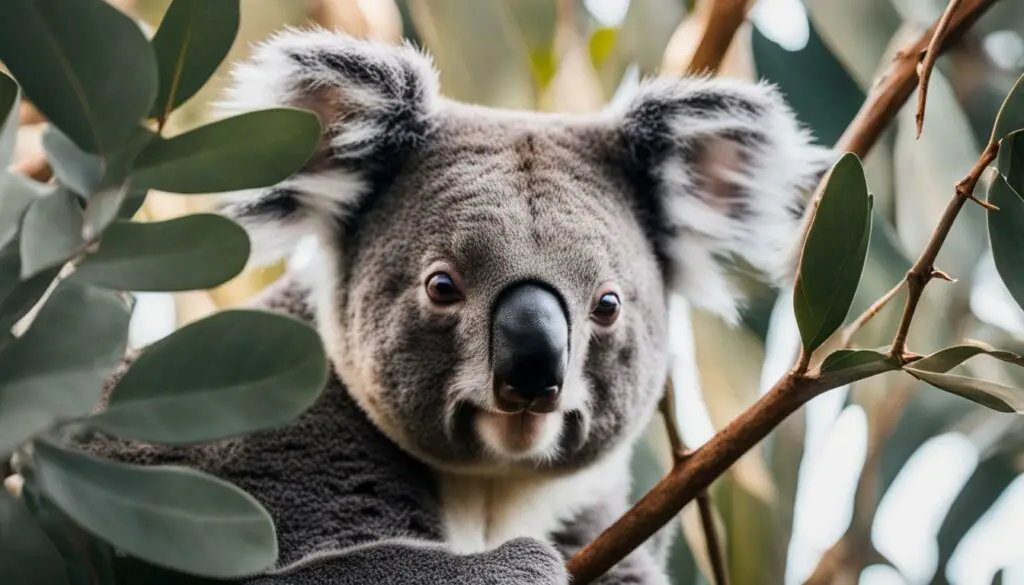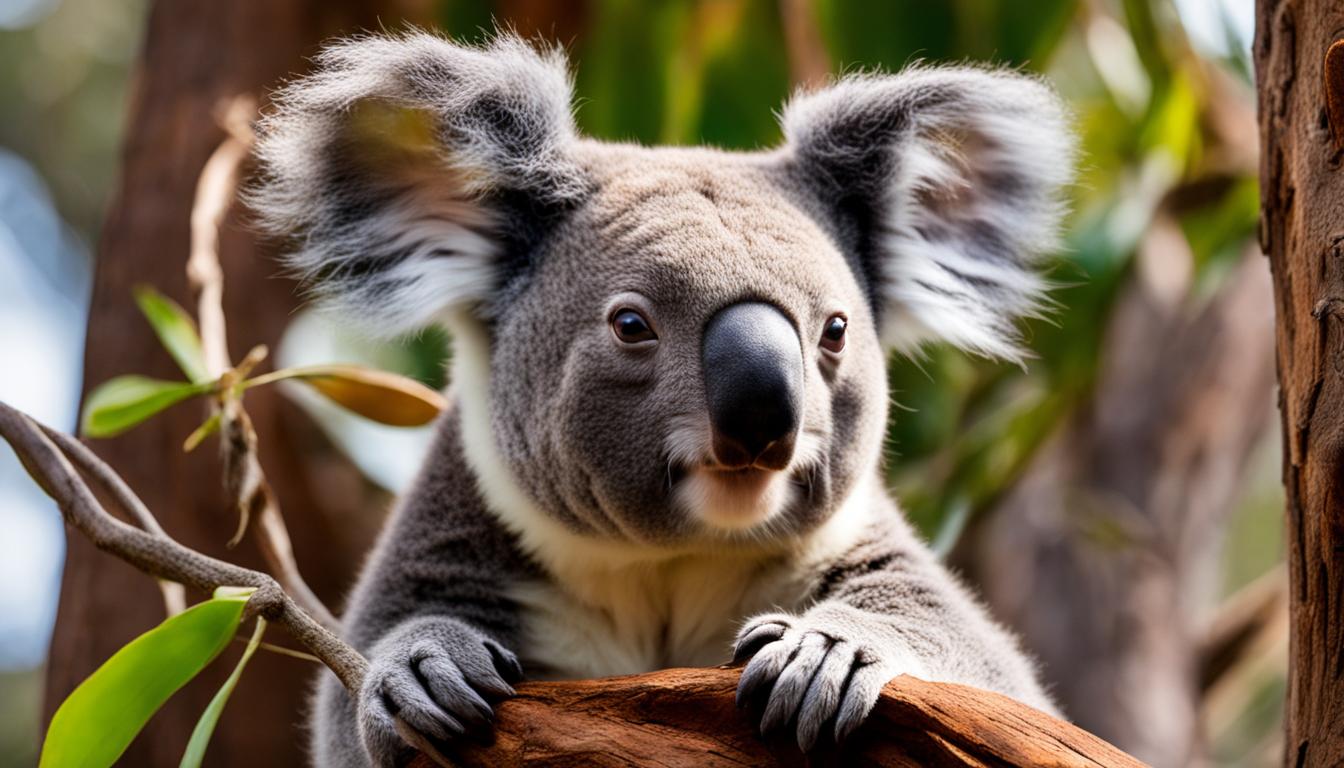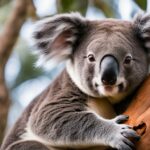When it comes to establishing territory, koalas have a unique method of communication – scent marking. This behavior allows them to assert their boundaries and interact with other koalas in their vicinity. Through scent marking, koalas convey important messages about their presence, mating intentions, and willingness to defend their territory.
Male koalas, in particular, use scent marking as a way to establish their home ranges. They may tolerate or challenge other males who encroach on their territory. Scent marking serves as a calling card for attracting potential mates and as a deterrent for rival males.
Scent marking becomes more frequent during the breeding season, and males are more likely to mark trees that have been occupied by other males. This behavior indicates a form of competition and territorial defense among koalas.
Stay tuned to learn more about the importance of scent marking for koalas, their behavior during scent marking, the role of their scent glands, and the fascinating world of koala scent marking.
The importance of scent marking for koalas
Scent marking is a vital behavior for koalas as it serves multiple purposes in their social and reproductive lives. By engaging in scent marking rituals and techniques, koalas establish and defend their territories, communicate with other koalas, and attract potential mates while deterring rival males. It plays a vital role in maintaining social structure and ensuring reproductive success.
Koalas use various signs and rituals to mark their territory, such as sniffing, rubbing their scent glands, and marking trees with their scent. These behaviors serve as communication signals to other koalas, conveying important messages about their presence, willingness to mate, and territorial boundaries. The scent markings act as a calling card, allowing koalas to establish their presence and claim ownership of their home ranges.
Furthermore, scent marking plays a significant role in mate selection and reproduction. The scents left behind by males can attract potential mates and signal their availability for mating. At the same time, these scents act as a deterrent for rival males, indicating a willingness to fight for a particular territory. The scent marks left behind by koalas can be detected by other koalas for days or even weeks after being deposited, ensuring a long-lasting communication method.
| Scent Marking Signs | Scent Marking Rituals | Scent Marking Techniques | Scent Marking Territory |
|---|---|---|---|
| Koalas sniff the surroundings to gather information about other koalas’ presence. | Koalas rub their scent glands against trees or objects to leave their scent behind. | Sniffing, rubbing scent glands | Scent marking is used to establish and defend their territories. |
| Scent marking becomes more frequent during the breeding season. | Scent marking acts as a calling card and a deterrent for other males. | Sniffing, rubbing scent glands | Koalas mark trees that have been occupied by other males to indicate territorial boundaries. |
The behavior of koalas during scent marking
During scent marking, koalas exhibit specific behaviors that help them effectively establish and defend their territories. A key aspect of this behavior is their approach to a tree or area where they want to mark their scent. Koalas will first sniff the surroundings, gathering information about the presence of other koalas in the vicinity. This initial investigation allows them to assess the territory and make informed decisions about where to mark their scent.
Once they have gathered information, koalas proceed to rub their scent glands, located on their chests, against the tree or object they wish to mark. This action leaves behind their distinctive scent, acting as a communication signal to other koalas in the area. By marking their territory, koalas are able to convey important messages about their presence, willingness to mate, and territorial boundaries.
Another interesting behavior exhibited during scent marking is the tendency for koalas to mark trees that have been recently occupied by other males. This behavior suggests a form of competition and territorial defense, as male koalas strive to assert their dominance and deter rival males from encroaching on their established territories.
This fascinating behavior of koalas highlights the intricate mechanisms they employ to communicate and navigate their environment. By understanding the behavior of koalas during scent marking, we gain valuable insights into their social structure and reproductive success.
The Role of Scent Glands in Koala Scent Marking
Koalas have prominent scent glands on their chests that play a significant role in their scent marking behavior. These scent glands produce a sticky, oily secretion that koalas use to leave their scent on trees and objects within their home range. The secretion contains chemical compounds that can be detected by other koalas for days or even weeks after it has been deposited.
These scent glands are more prominent in mature male koalas, and they become more active during the breeding season. This suggests that scent marking serves as a form of communication during the mating process. By marking their territory with their distinctive scent, male koalas communicate their presence, willingness to mate, and territorial boundaries to other koalas in the area.
The behavior of scent marking, combined with the scent glands, allows koalas to establish and defend their territories. When a male koala encounters a tree or an area where it wants to mark its scent, it will rub its scent glands against the tree or object, leaving behind its distinct odor. This behavior is repeated at various locations within the koala’s home range to effectively mark its territory.
“The scent glands and the behavior of scent marking are vital for communication among koalas,” says Dr. Jane Johnson, a wildlife biologist. “Through scent marking, koalas establish their presence, defend their territories, and attract potential mates. It’s a fascinating behavior that reflects the unique ways koalas navigate their environment.”
Understanding the role of scent glands in koala scent marking provides insights into their behavior and the importance of communication in their social structure. The fascinating world of koala scent marking continues to unravel as scientists delve deeper into their intriguing scent marking rituals and techniques.

The fascinating world of koala scent marking
Koala scent marking is a captivating behavior that these adorable creatures use to establish and defend their territories. Through scent marking, koalas communicate with other koalas, attract potential mates, and deter rival males. This intriguing behavior is an essential part of their social structure and reproductive success.
When engaging in scent marking, koalas exhibit specific behaviors and rituals. They approach a tree or area they want to mark and sniff the surroundings to gather information about other koalas’ presence. Then, using their prominent scent glands located on their chests, they rub their secretions against the tree or object to leave their distinct scent. This behavior is repeated at various locations within their home range to effectively establish their territory.
Not only does scent marking play a vital role in communication, but it also serves as a way for koalas to attract potential mates. By leaving their scent on trees and objects, they create a calling card for females, indicating their presence and readiness to mate. Additionally, scent marking serves as a deterrent for other males, signaling their willingness to fight for their territory and reinforcing their dominance.
The scent glands in male koalas produce a sticky, oily secretion that can be detected by other koalas for days or even weeks after being deposited. This allows for long-term communication and provides important information about territory boundaries and potential rivals. Understanding and studying koala scent marking provides valuable insights into their behavior and the unique ways in which they navigate their environment.
How does scent marking help koalas establish and defend their territory?
Scent marking is crucial for koalas to protect their territory. By leaving their scent on trees and other objects, koalas establish ownership and communicate with other koalas in the area. This helps them defend their space and prevent intruders from encroaching on their habitat, thus protecting dolphin conservation efforts.
FAQ
How do koalas use scent marking to establish territory?
Male koalas have home ranges that they live in and they may or may not tolerate other males using part or all of their home range. They use scent marking as a way to communicate with other koalas and establish their territory. Scent marking can serve as a calling card for attracting females or as a deterrent for other males. It can also indicate a willingness to fight for a particular territory. Scent marking becomes more frequent during the breeding season, and males are more likely to mark a tree that has been occupied by another male.
What signs and rituals do koalas use for scent marking?
Koalas use various signs and rituals to mark their territory, such as sniffing, rubbing their scent glands, and marking trees with their scent. This scent marking technique allows koalas to communicate with other koalas and convey important messages about their presence, willingness to mate, and territorial boundaries. Scent marking also plays a vital role in reproduction and mate selection, as it helps attract potential mates and deter rival males.
What behaviors do koalas exhibit during scent marking?
During scent marking, koalas approach a tree or an area where they want to mark their scent and sniff the surroundings to gather information about other koalas’ presence. They then rub their scent glands, located on their chests, against the tree or object to leave their scent behind. This behavior is repeated at different locations within their home range to effectively mark their territory. Koalas also tend to mark trees that have been recently occupied by other males, indicating a form of competition and territorial defense.
How do koalas use their scent glands during scent marking?
Male koalas have prominent scent glands on their chests, which produce a sticky, oily secretion. This secretion is used during scent marking to leave their scent on trees and objects in their home range. The scent glands are more prominent in mature males, and the marking behavior is more frequent during the breeding season. The scent produced by these glands can be detected by other koalas for days or even weeks after it has been deposited. The scent glands, along with the behavior of scent marking, play a crucial role in communication among koalas.
What is the importance of scent marking for koalas?
Koala scent marking is a crucial behavior that helps them establish and defend their territories. Through scent marking, koalas can communicate with other koalas, attract mates, and deter rival males. The behavior and rituals associated with scent marking, along with the prominent scent glands, play a vital role in maintaining social structure and reproductive success among koalas.










